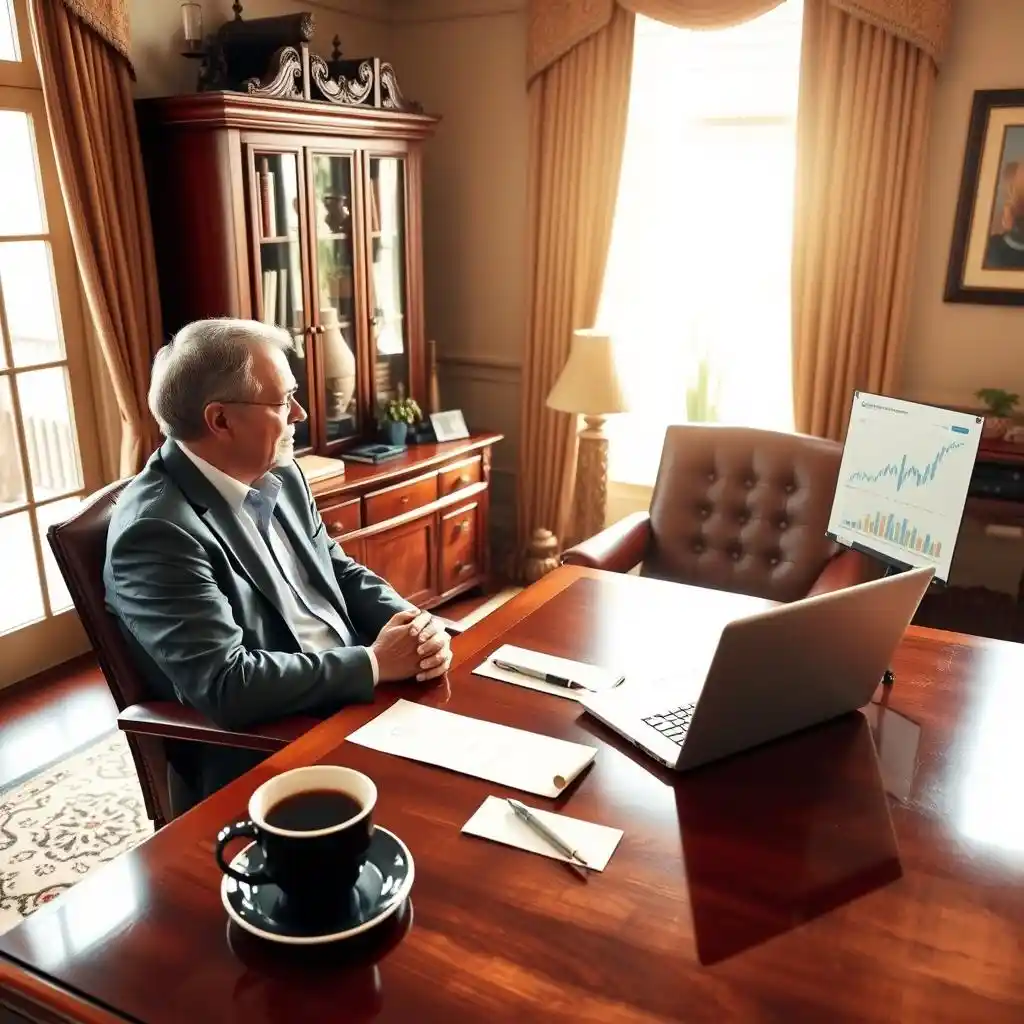Have you ever wondered if your financial advisor truly has your best interests at heart? With the growing complexity of financial markets, choosing the right professional to guide your investments and planning is more critical than ever. Trust is the cornerstone of any successful advisory relationship, yet many people struggle to identify who they can rely on.
We understand the challenges. Missteps in retirement planning or investment strategies can have long-lasting consequences. According to FINRA, advisor misconduct remains a concern, making due diligence essential. That’s why we’ve developed a clear, 9-step framework to simplify the selection process.

This guide blends practical steps with expert insights, helping you evaluate credentials, fee structures, and fiduciary duty. Our goal is to empower you to make informed decisions and build a partnership that aligns with your financial goals.
Key Takeaways
- Trust is the foundation of any financial advisory relationship.
- Complex markets require professional guidance to navigate effectively.
- A 9-step framework simplifies the selection process.
- Credentials and fiduciary duty are critical factors to consider.
- Due diligence helps avoid advisor misconduct and ensures reliability.
Why You Need a Financial Advisor
Navigating financial decisions alone can feel overwhelming, especially in today’s complex market. A professional can help you optimize your investment portfolio and manage cash flow effectively. This ensures your money works harder for you.
Market volatility is inevitable. Experts agree that having a trusted advisor can protect your assets during downturns. They provide strategies to minimize losses and keep your long-term goals on track.

Specialized services like estate planning and tax strategies are often overlooked. These areas require expertise to ensure your wealth is preserved and passed on efficiently. Without proper guidance, mismanagement can lead to significant losses.
Data shows that clients who work with professionals often achieve higher net returns. A Fidelity study found that those with advisors reported lower financial stress and greater confidence in their plans.
Managing finances on your own can be risky. While DIY approaches may seem cost-effective, they often lack the depth of professional strategies. Here’s a comparison:
| Aspect | DIY Management | Advisor-Guided Approach |
|---|---|---|
| Portfolio Optimization | Limited by personal knowledge | Tailored strategies based on expertise |
| Risk Management | Reactive to market changes | Proactive protection during volatility |
| Specialized Services | Often neglected | Comprehensive planning for taxes and estates |
Consider the case of inheritance mismanagement. Without proper guidance, beneficiaries often face unnecessary taxes and legal complications. A professional ensures your legacy is handled with care.
In summary, working with a trusted advisor can simplify complex financial situations. They provide clarity, reduce stress, and help you achieve your goals with confidence.
Step 1: Identify Your Financial Needs
Understanding your financial needs is the first step toward building a secure future. A tailored financial plan starts with knowing what you want to achieve. Whether it’s managing debt, saving for retirement, or investing wisely, clarity is key.

Personal Finance and Budgeting
Start by evaluating your income and expenses. Tools like the 50/30/20 rule can help. This method allocates 50% of your income to needs, 30% to wants, and 20% to savings. Zero-based budgeting is another effective approach, ensuring every dollar has a purpose.
Debt Management
Debt can be overwhelming, but strategies like the debt snowball or avalanche method can help. The snowball method focuses on paying off smaller debts first, while the avalanche targets high-interest debts. Choose the one that aligns with your goals and financial situation.
Investment Planning
Modern investment strategies, such as ESG (Environmental, Social, Governance) portfolios, are gaining popularity. These align your investments with your values while aiming for growth. A professional can help you diversify and manage risk effectively.
Retirement and Estate Planning
Planning for the future involves more than just saving. Estate planning essentials like wills and trusts ensure your assets are distributed according to your wishes. A well-structured financial planning services approach can protect your legacy and provide peace of mind.
“A clear financial plan is the foundation of long-term success.”
By identifying your needs, you can find a professional who aligns with your vision. Tools like Empower’s financial health assessment and Facet Wealth’s customized planning can guide you in this process. Start today and take control of your financial future.
Step 2: Know What Credentials to Look For
Credentials are the backbone of trust in financial guidance. Not all professionals are created equal, and understanding their qualifications ensures you’re working with someone who meets high standards. We’ll break down the key certifications and what they mean for your financial future.
Certified Financial Planner (CFP)
The Certified Financial Planner (CFP) designation is widely regarded as the gold standard in the industry. To earn this credential, professionals must complete 6,000+ hours of experience, pass a rigorous exam, and adhere to strict ethical standards. Karen Van Voorhis, a financial expert, calls the CFP “the gold standard for financial planning.”
CFPs are fiduciaries, meaning they are legally obligated to act in your best interest. This is a critical distinction from advisors who follow suitability standards, which only require recommendations to be “suitable” for your situation.
Registered Investment Advisor (RIA)
Registered Investment Advisors (RIAs) are registered with the SEC or state regulators. They are also fiduciaries, ensuring they prioritize your needs above their own. RIAs often provide comprehensive investment advice, including portfolio management and financial planning services.
Unlike brokers, RIAs are not tied to selling specific products. This independence allows them to offer unbiased recommendations tailored to your goals.
Here are some lesser-known credentials to consider:
- ChFC (Chartered Financial Consultant): Focuses on advanced financial planning strategies.
- CFA (Chartered Financial Analyst): Ideal for investment analysis and portfolio management.
- CPA/PFS (Certified Public Accountant/Personal Financial Specialist): Combines tax expertise with financial planning.
To verify credentials, use resources like the CFP Board’s database or the SEC’s IAPD tool. Additionally, check FINRA’s BrokerCheck for disciplinary history. Real cases of misconduct highlight the importance of due diligence.
“The CFP designation is the gold standard for financial planning.” – Karen Van Voorhis
By understanding these credentials, you can confidently choose a professional who aligns with your financial goals and values.
Step 3: Understand the Different Types of Financial Advisors
The financial advisory landscape offers diverse options to suit every need and budget. From automated platforms to personalized services, each type has unique advantages. Understanding these differences helps you choose the right fit for your goals.

Robo-Advisors
Robo-advisors like Betterment and Vanguard PAS provide low-cost, automated services. They are ideal for tech-savvy clients who prefer minimal human interaction. Betterment requires no minimum balance, while Vanguard PAS starts at $50,000.
These platforms use advanced algorithms to manage your account efficiently. Security measures like encryption and two-factor authentication ensure your data is protected. Brian Behl notes, “Tech-savvy clients often prefer robo-advisors for their convenience and affordability.”
Online Financial Planners
Hybrid models like Personal Capital combine technology with human expertise. They offer video consultations, making them accessible for clients who value flexibility. This approach bridges the gap between automation and personalized advice.
Zoe Financial’s vetting process ensures online planners meet high standards. These platforms are perfect for millennials and busy professionals who need tailored solutions without in-person meetings.
Traditional In-Person Advisors
Traditional advisors provide face-to-face guidance, ideal for high-net-worth individuals with complex needs. They offer comprehensive services, including estate planning and tax strategies. While more expensive, their personalized approach ensures every detail is addressed.
Case studies show that millennials often prefer robo-advisors, while high-net-worth individuals benefit from traditional advisors. Understanding your needs helps you decide which type aligns with your goals.
| Type | Cost | Minimum Balance | Best For |
|---|---|---|---|
| Robo-Advisors | 0.25% – 0.50% | $0 – $50,000 | Tech-savvy investors |
| Hybrid Models | 0.50% – 0.89% | $25,000 – $100,000 | Busy professionals |
| Traditional Advisors | 1% – 2% | $100,000+ | High-net-worth individuals |
“Tech-savvy clients often prefer robo-advisors for their convenience and affordability.” – Brian Behl
By understanding the different types financial advisors, you can make an informed decision that aligns with your needs and budget. Whether you choose automation, hybrid models, or traditional services, the right advisor can help you achieve your goals.
Step 4: Consider How Much You Can Afford to Pay
Understanding the cost of professional financial guidance is essential for making an informed decision. Different advisors may charge varying amounts based on their services and expertise. Knowing what you can afford ensures you get value without overspending.

Fee Structures: Percentage, Hourly, Flat Fee
Advisors typically use one of three fee structures: percentage-based, hourly, or flat fees. Percentage-based fees are calculated as a percentage of your assets under management (AUM), often around 1%. Hourly fees range from $150 to $400, while flat fees can be $1,000 or more for comprehensive plans.
Some advisors also use retainer models, charging a fixed amount annually. Understanding these structures helps you choose the most cost-effective option for your needs.
Cost Comparison: Robo-Advisors vs. Traditional Advisors
Robo-advisors like Empower charge between 0.49% and 0.89% AUM, making them affordable for tech-savvy investors. Traditional advisors, on the other hand, often charge 1% to 2% AUM, but they provide personalized services like estate planning and tax strategies.
Here’s a breakdown of median fees:
| Type | Fee Structure | Median Cost |
|---|---|---|
| Robo-Advisors | Percentage of AUM | 0.25% – 0.50% |
| Traditional Advisors | Percentage of AUM | 1% – 2% |
| Hourly Advisors | Hourly Rate | $150 – $400 |
Hidden costs like transaction fees and fund expenses can add up. Always ask for a detailed breakdown before committing. Negotiation is also an option, especially for high-net-worth individuals.
“Transparent pricing ensures you know exactly what you’re paying for.” – XY Planning Network
By comparing costs and understanding fee structures, you can find a professional who fits your budget and goals.
Step 5: Vet the Financial Advisor’s Background
Trusting someone with your finances requires thorough research and due diligence. A clean background and solid track record are essential for building confidence in your advisor. Let’s explore how to evaluate their history effectively.
Checking Credentials and Disciplinary History
Start by verifying their credentials. Look for certifications like CFP, CFA, or ChFC, which indicate expertise and ethical standards. Use tools like the CFP Board’s database or the SEC’s Investment Adviser Public Disclosure (IAPD) to confirm their qualifications.
Next, review their disciplinary history. Frequent firm changes or customer disputes can be red flags. FINRA’s BrokerCheck is a valuable resource for this. It provides detailed reports on complaints, regulatory actions, and employment history.
Using FINRA’s BrokerCheck
BrokerCheck allows you to search for an advisor’s professional background. Here’s what to look for:
- Employment history: Frequent job changes may indicate instability.
- Customer disputes: Multiple complaints could signal poor service.
- Regulatory actions: Disciplinary measures are a serious concern.
Additionally, review Form ADV Part 2A, which discloses an advisor’s services, fees, and potential conflicts of interest. This document is filed with the SEC and provides transparency about their operations.
“Interview at least three advisors before making a decision. This ensures you find someone who aligns with your goals.” – James Lee
Here’s a checklist to guide your research:
- Verify certifications and licenses.
- Check for disciplinary actions using BrokerCheck.
- Review Form ADV for transparency.
- Look for undisclosed conflicts of interest.
By taking these steps, you can make sure your advisor is trustworthy and qualified. A little effort now can save you from costly mistakes later.
Step 6: Ask the Right Questions
Asking the right questions can make all the difference in finding a trustworthy financial advisor. It’s not just about their qualifications but also how they align with your goals and values. We’ve compiled a list of essential questions to help you uncover potential conflicts and ensure transparency.
Fiduciary Duty
Start by asking if they are a fiduciary. This means they are legally obligated to act in your best interest. Advisors who follow suitability standards may recommend products that benefit them more than you. Marianela Collado, a financial expert, emphasizes, “A fiduciary oath ensures your advisor prioritizes your needs above their own.”
Fee Structure and Conflicts of Interest
Understanding how your advisor is compensated is crucial. Ask about their fee structure—whether it’s a percentage of assets, hourly, or flat fees. Dual-registered advisors may have conflicts, as they can earn commissions from selling certain products. Use NAPFA’s fiduciary oath template to evaluate their commitment to transparency.
Here’s a comparison of common fee structures:
| Fee Type | Description | Pros | Cons |
|---|---|---|---|
| Percentage of AUM | Charges a percentage of your assets under management | Aligns advisor’s success with yours | Can be costly for large portfolios |
| Hourly Rate | Charges per hour for advice | Affordable for one-time consultations | May lack ongoing support |
| Flat Fee | Fixed cost for specific services | Transparent and predictable | May not cover all needs |
For example, if an advisor recommends a 401(k) rollover, ask why. Analyze whether it benefits you or if they earn a commission. This helps uncover hidden opportunities or conflicts.
“A fiduciary oath ensures your advisor prioritizes your needs above their own.” – Marianela Collado
Download our checklist of 15 essential questions to guide your conversation. By asking the right questions, you can build a relationship based on trust and transparency.
Step 7: Evaluate Communication and Compatibility
Building a strong relationship with your financial advisor starts with clear communication. Compatibility ensures your goals are understood and met. We’ll guide you through evaluating these critical factors to find the right fit.
Start by creating an advisor compatibility scorecard. Include criteria like responsiveness, cultural competence, and communication style. This helps you objectively compare candidates and identify the best match for your needs.
Cultural competence is essential in financial planning. Advisors who understand your background and values can provide more personalized service. This ensures your financial strategy aligns with your unique circumstances.
Analyze communication frequency preferences. Some clients prefer monthly updates, while others need quarterly check-ins. Discuss these expectations upfront to avoid misunderstandings later.
Compare client portal features across platforms. A user-friendly portal saves time and enhances transparency. Look for features like real-time portfolio tracking, secure messaging, and document sharing.
Personality assessment tools like DISC and MBTI can also help. These tools evaluate communication styles and compatibility. For example, Daniel Galli & Associates uses a detailed client matching process to ensure alignment.
“Emotional support during market volatility is crucial. A good advisor provides reassurance and keeps you focused on long-term goals.” – Corbin Blackwell
Watch for red flags in communication. Poor responsiveness, vague answers, or lack of transparency are warning signs. These issues can lead to frustration and unmet expectations.
| Factor | What to Look For |
|---|---|
| Responsiveness | Timely replies to emails and calls |
| Cultural Competence | Understanding of your background and values |
| Communication Style | Clear, concise, and tailored to your preferences |
By evaluating communication and compatibility, you can build a partnership that fosters trust and success. Take the time to assess these factors—it’s worth the effort.
Step 8: Review the Advisor’s Investment Philosophy
Your advisor’s investment philosophy shapes how your money grows and stays protected. It’s essential to understand their approach to managing your portfolio and how it aligns with your goals. Let’s explore key factors to consider when evaluating their strategy.
Start by comparing active vs. passive management. Active management involves frequent buying and selling to outperform the market, while passive strategies focus on long-term growth through index funds. Both have pros and cons, so choose one that matches your risk tolerance and financial objectives.
Next, discuss ESG (Environmental, Social, Governance) integration. Some advisors prioritize sustainable investments, while others may not. Ask how deeply ESG principles are embedded in their strategy. This ensures your money supports causes you care about.
Tactical vs. strategic asset allocation is another critical factor. Tactical allocation involves short-term adjustments based on market conditions, while strategic allocation focuses on long-term goals. Understanding their approach helps you gauge how they’ll handle market volatility.
Analyze sample portfolio stress tests to see how their strategies perform during downturns. Historical performance during market crashes can reveal their ability to protect your assets. Morningstar’s style box analysis is a useful tool for evaluating diversification and risk levels.
“Aligning your investment philosophy with your advisor’s approach is crucial for long-term success.” – Matt Chancey
Finally, consider Vanguard’s principles for investing success. These include staying disciplined, diversifying your portfolio, and keeping costs low. By reviewing these factors, you can ensure your advisor’s philosophy aligns with your financial vision.
Step 9: Make the Decision and Hire the Advisor
The final step in choosing a financial advisor is making the decision and formalizing the partnership. This process involves careful preparation and clear communication to ensure a smooth start to your professional relationship.
Preparing for the Initial Consultation
Before your first meeting, create a checklist to guide the discussion. Include questions about their investment philosophy, fee structure, and how they handle market volatility. Bring relevant documents like tax returns, investment statements, and retirement account details.
Understanding Form CRS (Customer Relationship Summary) is essential. This document outlines the advisor’s services, fees, and potential conflicts of interest. Review it thoroughly to ensure transparency.
Signing the Agreement
When it’s time to sign the agreement, compare RIA (Registered Investment Advisor) and broker-dealer contracts. RIAs are fiduciaries, meaning they must act in your best interest. Broker-dealers may follow suitability standards, which can lead to conflicts.
Discuss power of attorney considerations. This ensures your advisor can act on your behalf if needed. Outline termination clauses and exit strategies to protect your interests if the relationship doesn’t work out.
Document retention is another critical factor. Advisors should keep records for at least five years. Use resources like the Garrett Planning Network’s contract template to ensure all bases are covered.
“Early career advisors often bring fresh perspectives and a strong commitment to client success.” – Lei Deng
Here’s a comparison of RIA and broker-dealer agreements:
| Aspect | RIA | Broker-Dealer |
|---|---|---|
| Fiduciary Duty | Legally required to act in your best interest | Follows suitability standards |
| Fee Structure | Transparent, often percentage-based | May include commissions |
| Conflict of Interest | Minimal, as they don’t sell products | Potential conflicts due to product sales |
By following these steps, you can confidently hire an advisor who aligns with your goals and values. This ensures a strong foundation for your financial future.
Tips for Finding a Financial Advisor You Can Trust
Choosing the right financial professional requires careful consideration and thorough research. A trustworthy advisor can help you achieve your goals while ensuring your financial security. Here’s a step-by-step guide to help you make sure you’re making the best choice.
Start by verifying their SEC/FINRA registration status. This ensures they are legally authorized to provide financial advice. Use the CFP Board sanctions database to check for any disciplinary actions. A clean record is a strong indicator of reliability.
Attend local FPA (Financial Planning Association) chapter events to meet professionals in your area. Networking can provide valuable insights and help you find advisors with a strong reputation. Additionally, request client references from individuals in similar financial situations. This gives you a clearer picture of their expertise and approach.
Evaluate third-party custodian arrangements. This ensures your assets are held securely and independently. Test their responsiveness by sending an urgent query. A prompt reply indicates their commitment to client service.
Consult resources from the Foundation for Financial Planning for additional guidance. These tools can help you understand what to look for in an advisor. Platforms like Zoe Financial use advanced matching algorithms to connect you with professionals who meet your specific needs.
| Step | Action |
|---|---|
| 1 | Verify SEC/FINRA registration |
| 2 | Check CFP Board sanctions |
| 3 | Attend local FPA events |
| 4 | Request client references |
| 5 | Evaluate third-party custodians |
| 6 | Test responsiveness |
| 7 | Consult Foundation resources |
| 8 | Use Zoe Financial’s algorithm |
By following this list, you can confidently select a financial advisor who aligns with your goals and values. Taking the time to research and evaluate ensures a partnership built on trust and success.
Conclusion
Securing your financial future starts with the right partnership. Our 9-step verification process ensures you find a professional who aligns with your goals and values. Ongoing monitoring is essential to adapt to life changes and asset milestones.
Re-evaluation triggers, like career shifts or family events, help keep your strategy on track. Continuing your financial literacy journey empowers you to make informed decisions. Resources like the NAPFA and CFP Board are invaluable for further guidance.
Success stories highlight the impact of proper advisor selection. As Kyle McBrien says, “Alignment with your goals is the foundation of financial success.” Download our advisor comparison checklist to take the next step toward a secure future.
FAQ
Why do I need a financial advisor?
A financial advisor helps you manage your money, plan for retirement, and achieve your financial goals. They provide expertise in areas like investments, budgeting, and estate planning.
What credentials should I look for in a financial advisor?
Look for certifications like Certified Financial Planner (CFP) or Registered Investment Advisor (RIA). These credentials ensure the advisor has met specific education and ethical standards.
What are the different types of financial advisors?
There are robo-advisors, online financial planners, and traditional in-person advisors. Each type offers different levels of service and interaction based on your needs.
How much does a financial advisor cost?
Costs vary depending on the fee structure. Some charge a percentage of assets under management, while others may charge hourly or flat fees. Robo-advisors are often more affordable than traditional advisors.
How do I vet a financial advisor’s background?
Use tools like FINRA’s BrokerCheck to verify credentials and check for any disciplinary history. This ensures the advisor has a clean record and is trustworthy.
What questions should I ask a financial advisor?
Ask about their fiduciary duty, fee structure, and potential conflicts of interest. This helps you understand if they prioritize your best interests.
How do I know if a financial advisor is the right fit?
Evaluate their communication style, investment philosophy, and how well they understand your goals. Compatibility is key to a successful partnership.
What happens during the initial consultation?
The advisor will discuss your financial situation, goals, and needs. It’s an opportunity to see if their services align with what you’re looking for.
How do I hire a financial advisor?
After the consultation, review the agreement carefully. Ensure you understand the terms, fees, and services before signing.












